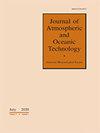基于二极管激光的直接探测多普勒激光雷达垂直风廓线性能建模
IF 1.9
4区 地球科学
Q2 ENGINEERING, OCEAN
引用次数: 2
摘要
用于水蒸气、温度和气溶胶剖面的微脉冲差分吸收激光雷达(MPD)已经开发、演示,并正在满足大气科学界对能够长期监测对流层低层的低成本地面联网仪器的需求。MPD仪器使用基于二极管激光器(DLB)的架构,可以很容易地适应广泛的应用。在这项研究中,基于当前MPD架构的DLB直接探测多普勒激光雷达被建模,以更好地了解该仪器对垂直风速测量的功效,长期目标是将这些测量纳入当前MPD仪器网络。直接探测多普勒激光雷达基于双边缘接收器,该接收器利用两个法布里-珀罗干涉仪和垂直速度反演,该垂直速度反演需要辅助测量反向散射比,即总反向散射系数与分子反向散射系数的比。本文中的建模说明了误差的主要来源。这表明,在距离分辨率为150米、平均时间为5分钟的情况下,垂直速度可以在4公里以下以小于0.56米s−1的误差进行反演。本文章由计算机程序翻译,如有差异,请以英文原文为准。
Performance Modeling of a Diode-Laser-Based Direct Detection Doppler Lidar for Vertical Wind Profiling
Micropulse differential absorption lidar (MPD) for water vapor, temperature, and aerosol profiling have been developed, demonstrated, and are addressing the needs of the atmospheric science community for low-cost ground-based networkable instruments capable of long-term monitoring of the lower troposphere. The MPD instruments use a diode-laser-based (DLB) architecture that can easily be adapted for a wide range of applications. In this study, a DLB direct detection Doppler lidar based on the current MPD architecture is modeled to better understand the efficacy of the instrument for vertical wind velocity measurements with the long-term goal of incorporating these measurements into the current network of MPD instruments. The direct detection Doppler lidar is based on a double-edge receiver that utilizes two Fabry-Perot interferometers and a vertical velocity retrieval that requires the ancillary measurement of the backscatter ratio, which is the ratio of the total backscatter coefficient to the molecular backscatter coefficient. The modeling in this paper accounts for the major sources of error. It indicates that the vertical velocity can be retrieved with an error of less than 0.56 m s−1 below 4 km with a 150-m range resolution and an averaging time of five minutes.
求助全文
通过发布文献求助,成功后即可免费获取论文全文。
去求助
来源期刊
CiteScore
4.50
自引率
9.10%
发文量
135
审稿时长
3 months
期刊介绍:
The Journal of Atmospheric and Oceanic Technology (JTECH) publishes research describing instrumentation and methods used in atmospheric and oceanic research, including remote sensing instruments; measurements, validation, and data analysis techniques from satellites, aircraft, balloons, and surface-based platforms; in situ instruments, measurements, and methods for data acquisition, analysis, and interpretation and assimilation in numerical models; and information systems and algorithms.

 求助内容:
求助内容: 应助结果提醒方式:
应助结果提醒方式:


